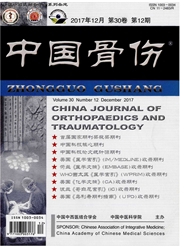

 中文摘要:
中文摘要:
目的 :对选择内固定与人工关节置换术治疗转子间骨折的患者进行生存分析,比较两种术式对老年人转子间骨折死亡率的影响。方法:回顾性分析2003年4月至2013年5月收治的110例60岁以上选择内固定或关节置换治疗的股骨转子间骨折患者的临床资料。其中选择内固定手术治疗组83例,男32例,女51例;年龄61.44~98.75岁,平均(78.52±7.98)岁。关节置换组27例,男8例,女19例;年龄71.82~96.54岁,平均(79.99±6.11)岁。观察两组患者的当前生存情况,第1、2、5年总体生存率及平均生存期;两组患者第1、2年死亡率;两组患者第1、2年生存率及平均生存期。结果:所有患者获得随访,时间1~125个月,平均(46.93±29.53)个月。所有患者伤口甲类愈合,无院内死亡病例。其中31例患者死亡,79例患者存活,生存分析显示全部110例患者的1、2、5年生存率分别为(90.7±2.8)%、(82.5±3.9)%和(57.6±6.5)%,平均生存期为(84.137±5.902)个月。内固定组术后1、2年死亡比例分别为7.2%和12.0%,关节置换组分别为14.8%和25.9%,两组比较差异无统计学意义。内固定组1年生存率为(92.6±2.9)%,2年生存率为(85.8±4.3)%,平均生存期为(87.508±6.063)个月,关节置换组分别为(85.2±6.8)%和(73.9±8.5)%,平均生存期为(67.294±11.180)个月,两组比较差异有统计学意义(χ2=6.402,P〈0.05)。结论 :选择内固定手术较人工关节置换术治疗的老年转子间骨折患者术后总体生存情况较佳。
 英文摘要:
英文摘要:
Objective:To determine the difference of post operative mortality between ORIF(open reduction internal fixation) and hip replacement for the treatment of intertrochanteric fracture in elderly by using survival analysis. Methods:The clinical data of 110 patients above 60 years old who underwent surgical treatment(ORIF or hip replacement) for the intertrochanteric fracture between April 2003 and May 2013 were retrospectively analyzed. Among the patients,83 cases were treated with ORIF(ORIF group),there were 32 males and 51 females,aged from 61.44 to 98.75 years old with an average of(78.52±7.98) years old;and 27 cases were treated with hip replacement(arthroplasty group),there were 8 males and 19 females,aged from 71.82 to 96.54 years old with an average of(79.99±6.11) years old. A survival analysis was performed on the clinical data by using SPSS 13.0 software. The survival rate of 1 year,2 year,5 year and the mean survival time for the total patients,the mortality rate of 1 year,2 year in each group,the survival rate of 1 year,2 year and mean survival time and survival curve in each group were included. Results:All wounds achieved primary healing and no deaths were found in stay hospital.All patients were followed up from 1 to 125 months with an average of(46.93±29.53) months. Among all 110 cases,31 were dead and 79 survived. The survival rate of 1 year,2 year and 5 year was(90.7±2.8)%,(82.5±3.9)% and(57.6±6.5)%,respectively,while the ensemble mean survival time was(84.137±5.902) months. The mortality rate of 1 year,2 year in ORIF group was 7.2% and 12.0%,respectively;and in arthroplasty group,there was 14.8% and 25.9%,respectively. There was no significant difference in mortality rate of 1 year and 2 year between two groups. According to the survival analysis of the ORIF group,the survival rate of 1 year,2 year was(92.6±2.9)%,and(85.8±4.3)%,respectively,and the mean survival time was(87.508±6.063) months. In arthroplasty group,the survival r
 关于廖威明:
关于廖威明:
 关于傅明:
关于傅明:
 关于康焱:
关于康焱:
 同期刊论文项目
同期刊论文项目
 同项目期刊论文
同项目期刊论文
 期刊信息
期刊信息
